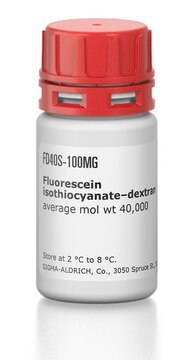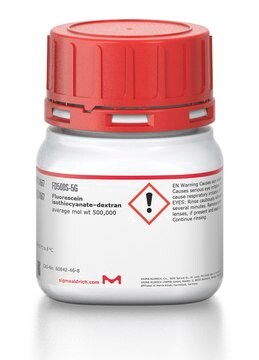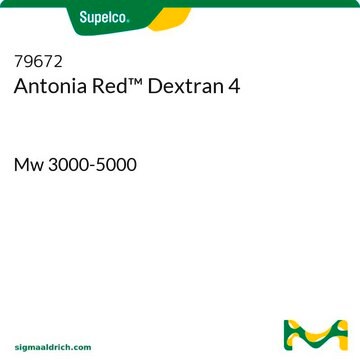FD4
Fluorescein isothiocyanate–dextran
average mol wt 3,000-5,000
Synonym(s):
FITC–Dextran
About This Item
Recommended Products
biological source
synthetic
conjugate
FITC conjugate
form
powder
mol wt
average mol wt 3,000-5,000
extent of labeling
0.001-0.020 mol FITC per mol glucose
technique(s)
HPLC: suitable
color
light yellow to dark orange
solubility
H2O: 25 mg/mL
suitability
suitable for HPLC
suitable for fluorescence indicator
suitable for fluorescent labeling techniques
application(s)
life science and biopharma
metabolomics
microbiology
pharmaceutical
Looking for similar products? Visit Product Comparison Guide
General description
In biochemical investigations focused on the blood-brain barrier (BBB), FITC-Dextran, particularly the variant with an average molecular weight of 4000, holds a central role. It serves as a dependable tool for evaluating the permeability of solutes, ions, and proteins across the BBB, facilitating an improved understanding of the barrier′s integrity and any potential disruptions. This contribution to biochemical exploration is invaluable in shedding light on the brain′s defense mechanisms.
Additionally, FITC-Dextran plays a pivotal role in studies related to cell permeability within the area of biochemical research. This extends to the assessment of BBB permeability and the extent of disruptions within the BBB, aspects that are fundamental to neuroscience and drug delivery research. These biochemical research facets are essential for comprehending disease mechanisms and formulating effective therapeutic strategies.
Furthermore, FITC-Dextran is a cornerstone in cardiovascular, microcirculation, and perfusion studies. It operates as a fluorescent flux tracer compound, allowing for the measurement of critical processes like blood flow, membrane integrity, vascular drainage, and renal elimination. In conclusion, FITC-Dextran proves to be an indispensable asset in the fields of biology, biochemistry, and medicine, offering unparalleled insights into the intricacies of cellular and tissue permeability, the integrity of the blood-brain barrier, and the understanding of diverse physiological and pathological processes.
Application
- as a tracer molecule in membrane permeability study[1]
Biochem/physiol Actions
Features and Benefits
- Suitable for Biochemical and Biomedical research
- Versatile and adaptable for wide variety of laboratory and research applications
Preparation Note
Other Notes
comparable product
signalword
Warning
hcodes
Hazard Classifications
Eye Irrit. 2 - Skin Irrit. 2 - STOT SE 3
target_organs
Respiratory system
Storage Class
11 - Combustible Solids
wgk_germany
WGK 3
flash_point_f
Not applicable
flash_point_c
Not applicable
ppe
Eyeshields, Gloves, type N95 (US)
Choose from one of the most recent versions:
Already Own This Product?
Find documentation for the products that you have recently purchased in the Document Library.
Customers Also Viewed
Articles
Explore FITC-labelled polysaccharides and their properties, including impact of molecular weight on molecule dimensions.
Related Content
Dextran is a polymer of anhydroglucose. It is composed of approximately 95% alpha-D-(166) linkages. The remaining (163) linkages account for the branching of dextran.
Our team of scientists has experience in all areas of research including Life Science, Material Science, Chemical Synthesis, Chromatography, Analytical and many others.
Contact Technical Service











